Georgia Kotretsos is a visual artist, writer, and curator currently based in Athens, Greece. She earned a MFA from the School of the Art Institute of Chicago and a BFA from The Durban Institute of Technology, KwaZulu Natal, South Africa. Born in Greece, raised in South Africa and repatriated in 2005, she was educated in South Africa and the United States and since has worked in studios across the globe. I first met Georgia in 2003 while she was an ambitious graduate student. Since then, her ambition continues to grow alongside a fierce intellectual curiosity, a passion for art, and a spirit that is truly her own. She has exhibited her work at many venues in Chicago, St. Louis, New York, Athens, Istanbul, Berlin, Rome, Bitola, Macedonia (FYROM), and Durban, South Africa. In 2010, she was awarded the Summer Studio Program Residency from The School of the Art Institute of Chicago. She curated a recent solo exhibition with artist Serkan Ozkaya, among others, and has curated and initiated many group exhibitions with emerging artists in the United States and Athens. She co-founded Boots Contemporary Art Space in St. Louis and was founder and editor-in-chief of Boot Print, a publication dedicated to global contemporary art, from 2006-2010. She wrote the foreword for Pablo Helguera’s Artoons. Volume 3, published in 2011. She has published many articles on contemporary art and artists’ practice, including the dozens of insightful tours she has taken us on through artists’ studios as a regular columnist for this blog!
Interested in art history, institutional critique, and art audiences, many of Georgia’s projects often center on notions of looking, specifically looking at the various relationships that unfold around experiencing a work of art, as seen in museums. She begins her inquiry through a reconsideration of traditional and contemporary art masterpieces located in prominent museum galleries across the globe. As a voyeur, she then observes and documents visitors’ engagement and responses to these works. Concerned with the phenomenology of the viewer, she literally and conceptually (re)frames the conditions of observation, cultural tourism, and the memory of such experiences in compelling new narratives that create yet another access point to a work of art. As such, her work functions as a conduit between image making, images, and the beholder, thus narrowing the space between the function of art, art museums, and audience expectation. She effectively challenges meaning as a construct derived both from works of art, as objects, and the experience of seeing, as spectacle. Often employing materials that echo content, Georgia’s discursive acts of re-articulation thoughtfully and wittingly blur conceptual boundaries between authorship and authority, ownership and circulation, and positions of seeing and power.
On the occasion of her exhibition at TinT Gallery, Thessaloniki, Greece, I am delighted to share what is happening with Georgia!
Shannon Fitzgerald: Can you describe your working environment, the conditions you require for productivity, and how your studio functions as a site for your creative practice, as an artist? As a writer? A curator?
Georgia Kotretsos: The ground floor of the house I’m staying at has been my studio for nearly 6 years now. It’s my base, where I have shipped my books and works from both South Africa and the States. I spend endless hours in there. This is where I make work, read, think, write — I have a cocoon-like office area and yeah, in regards to curating – I don’t really curate in the sense most curators do, but I have given myself the liberty to showcase some of my peers’ work when I can and want to. I don’t believe in roles, I’m in the art ‘business’ and as an artist, all parameters of this industry are of my concern.
In regards to the space itself, it is about 40 minutes out of the city center, I have very little traffic here and I treasure the luxury of having olive and orange trees outside my door and the beach within walking distance. As dysfunctional as downtown Athens is, this very quality is its charisma too. I do indulge in Athenian doses often – it has quite a potent and if I may, positive — affect on my work.
The conditions that are required for my productivity differ significantly from my current working environment. I have a studio wish-list too. I work a lot with technicians and craftsmen outside my studio as I have things made elsewhere and sometimes when the installation of a piece is necessary, the domestic feel of the space gets in the way. A raw space with concrete rather than tiled floors with a large door and a high ceiling would’ve been ideal. A 90 cm wide b/w copier, a large scanner, and a great assistant would make my studio-life a pure joy.
SF: You currently have a two-person exhibition of new work on view at TinT Galley in Thessaloniki, Greece. Can you discuss your show and how you arrived at this particular project?
GK: Last summer, I was an artist-in-residence at the Summer Studio Program at the School of the Art Institute of Chicago and I had the opportunity to revisit familiar places, such as the Art Institute of Chicago. Although this time around, I had the opportunity to visit the Modern Wing of AIC for the first time. I wasn’t expecting anything — as it was my first visit, I was planning to return to the museum on a daily basis hoping to collect information as usual about audiences and their choreography.
Casually during that visit, I raised my hand to take a shot of Thomas Struth’s photograph Art Institute of Chicago II (1989), which depicts Paris Street, Rainy Day (1877), by Gustave Caillebotte, also displayed in the impressionist gallery of AIC, while it was being viewed by an artist friend. I instantly knew I had the beginning of this recent body of work in my hands.
All it took was a quick glance through the viewfinder to know that I’d use Thomas Struth’s museum photos for this new body of work.
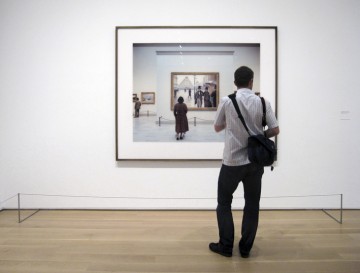
Georgia Kotretsos, “Being-seen-by-another is the truth of seeing the other – The Art Institute of Chicago, Modern Wing, No. 1 2010,” archival inkjet print, 82 x 70 cm, 2011.
Originally, I was planning to use photographs that I have taken over the years at museums, as economizing, recycling, and reusing images of the art world is a practice that goes hand-in-hand with my work. I do not wish to reproduce something when it already exists; I much rather prefer to continue the conversation from where an artist might have left off. Some works are open invitations; they lead to new works. On that very logic, in the past from the Art Institute of Chicago, I have taken 8741 pieces of Candy from Felix Gonzalez-Torres’s Untitled (Portrait of Ross in LA) (1991), to re-create the ideal weight of Ross Laycock, who died of AIDS/HIV. I showed that piece in Durban, South Africa, at the NSA Gallery, curated by Storm van Rensburg in 2003. The piece already allowed me to take a piece of candy at a time, so why not take as many as I should to re-create the piece? Why shouldn’t I walk in and out the museum 8741 times?
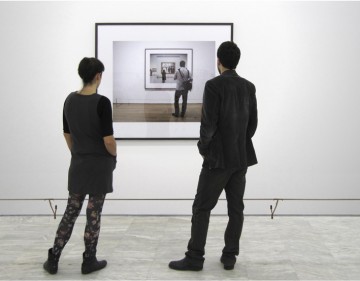
Georgia Kotretsos, “Being-seen-by-another is the truth of seeing the other” National Museum of Contemporary Art (EMST), No. 2 Athens, 2010,” archival inkjet print, 82 x 70 cm, 2011.

Georgia Kotretsos, “Being-seen-by-another is the truth of seeing the other – Macedonian Museum of Contemporary Art (MMCA), No. 3 Athens, 2010,” archival inkjet print, 82 x 70 cm, 2011.
The same method was applied here. So, once that first photo was taken, I thought it’d be exciting upon my return to Greece to print this image in approximately the same size as Struth’s photo at AIC and photograph it at the National Museum of Contemporary Art (EMST) in Athens, and then print the photo taken at EMST and photograph it at the Macedonian Museum of Contemporary Art (MMCA) in Thessaloniki, where ARThood would take place and then print the photo taken at EMST and photograph it at the Macedonian Museum of Contemporary Art (MMCA) in Thessaloniki.
Being-seen-by-another is the main piece of this body of work. I give great emphasis on the process and the origin of ideas. I want to be able to trace my train of thought to its point of departure. I do not work intuitively. I have to understand the choices I make. Especially, when I use as references other artists’ work, I somehow have to understand the implications, problems, and conversations such an action may raise.
In total, I’ll be showing 16 works: a series of 13 collages based on Struth’s museum photos, the triptych Being-seen-by-another is the truth of seeing the other, the diptych After Struth – Painting Silhouettes, and Approximately the 662.947.200 moment set in stone, Art Institute of Chicago II, 1990, a marble wall piece I hope we have the opportunity to discuss later.
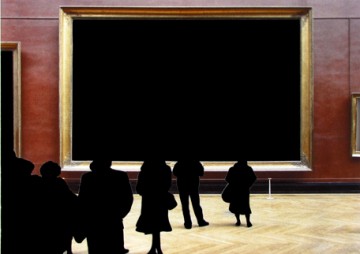
Georgia Kotretsos, "After Struth Series - Musee du Louvre IV, 1989, Paris," 53 x 44 cm, Plexi glass, archival paper and ink, framed, 2011.
SF: Institutional critique, a reconsideration of art history, and the role of the viewer and audience have been unifying themes in many of your projects, beginning with your graduate work. Can you elaborate on how this essential research-based and conceptually motivated line of inquiry is so critical to your practice?
GK: Thank you, Shannon, for this question, because you’re taking me back to a piece where I clearly understood what I was after in pursuing art. I was schooled and educated in the late 90s in South Africa, and it always seemed to me that the slides that were flashed before my eyes in art history classes and the images I was studying in art history books were my reality, my experience of Western art. My entire undergraduate education is based on obscure experiences of art. Imagining a work in real life became second nature. Somehow, this Western art business seemed so far away… I never thought I was far away from art, because South Africa at the time was coming out of its shell and it was bursting with art and creativity, but nonetheless, that Western stuff, for all I knew, could have existed on the moon. I formed opinions about the Mona Lisa from an art history book, where it was reproduced in a two doubles — a battery-sized image. That image became my understanding and knowledge of it.
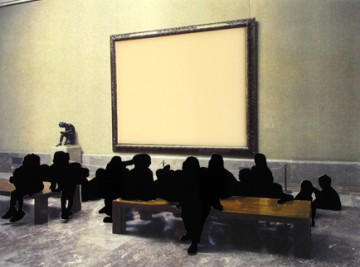
Georgia Kotretsos, "After Struth Series - Museo de Prado I, 2005, Madrid," 45 x 39 cm, Plexiglass, archival paper and ink, framed, 2011.
Between 1999 and 2002, I had the opportunity to travel extensively in Europe, where I visited some of the major museums where these “tiny” Western treasures were safely kept. And, that was it…. there were fireworks. At the Louvre, The Raft of the Medusa by Gericault swallowed me; the experiences were endless! They still are for me when I find myself in from of an artwork. How can I make art if I haven’t seen art, but only in reproductions – or at least have not seen the art that I was taught, the art all artists of my generation were taught. Being told that’s art – it’s not enough, I’ve got to see it for myself. First, I am a critical viewer and then an artist.
These eye-opening visits made me question my knowledge of art. I erased my hard drive and I started from scratch, taking in as much as I could. I started studying how these works were viewed by others; how people moved in these visual libraries; how much time they spent in front of these artworks.
When I moved to the States in 2002 to attend the MFA program at the School of the Art Institute of Chicago, my sculpture studio was behind the Art Institute of Chicago and although I had the option to go to use the school’s entrance, I made it my daily routine, to come in and out my studio through the museum. I got to know the place like the back of my hand. To be honest, as a student, I spent more time in the museum with a stopwatch in hand than at my studio.
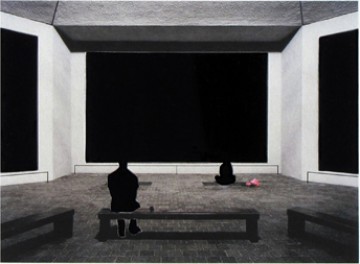
Georgia Kotretsos, "After Struth" series, "Rothko Chapel, 2007, Houston," 28 x 24 cm, Plexiglass, archival paper and ink, framed, 2011.
Somehow, I wanted to broaden the dialogue I was experiencing and began to question the knowledge of informed audiences in relationship to memory and the way in which we recall some of the paintings that make up the Western art historical canon. So, when it came to presenting a graduate piece, I kept it simple by wanting to find out how much physical space these works would take up in our head if we had to experience them all in person and how we recall them. So, I outlined the exact dimensions of 52 prominent historical paintings such as: The Birth of Venus by Botticelli, Liberty Leading The People by Delacroix, Les Demoiselles d’Avignon by Picasso, and Three Flags by Jasper Johns by using black thread, sewing needles, and placing the title of each piece in black vinyl lettering on the bottom left-hand corner of each painting. It became a web, it read as one piece. The area all 52 paintings would take up in our headspace would be approximately 1980 square feet (184 square meters). And then I stood in the background and studied for the duration of the show how and if this hollow piece worked and on what level. The funny thing was that often people would glance at it for seconds and move on to the next piece, and suddenly I’d hear them coming back going, “Aha!… that’s what it is…” and they’d stand with their friends for several minutes in front of it recalling and projecting back onto that wall the paintings that corresponded to the titles. Hundreds of people visited that show and each one who read Mona Lisa on the wall brought the painting to mind as they remember it and as they have experienced it in person, or from a slide, or a book.
They had to fit it to its exact dimensions on the wall and of course although I cannot record how the work was remembered, I somehow suspect that there were as many versions of the Mona Lisa recalled as visitors who read the title on the wall. Cultural consumption has power and it has an egalitarian feel to it. How do we know these paintings? What is our knowledge of Western art is a question we can only answer for ourselves.
Beginning with the piece Approximately 1980 Square Feet, institutional critique and the reconsideration of art history became my focus. The acquisition of art knowledge is relative and although we now have access to the web and to super gadgets that offer an alternative experience of art, I choose to work by going back to valuing and appreciating the significant and individual in-person art experience.
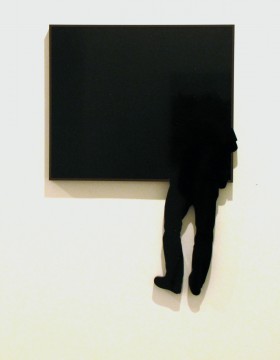
Georgia Kotretsos, "Αpproximately the 662.947.200 moment set in stone, AIC," 2011. Black marble, brown metal frame, 90 x 62 x 3 cm.
SF: Thank you Georgia!
Shannon Fitzgerald is a curator, writer, and educator living in Oklahoma City.
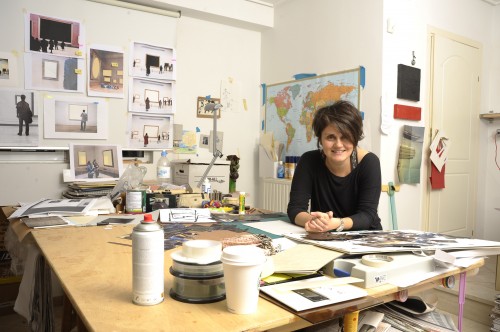
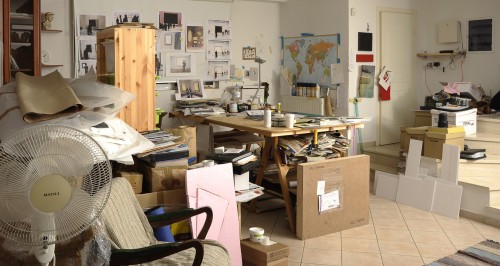
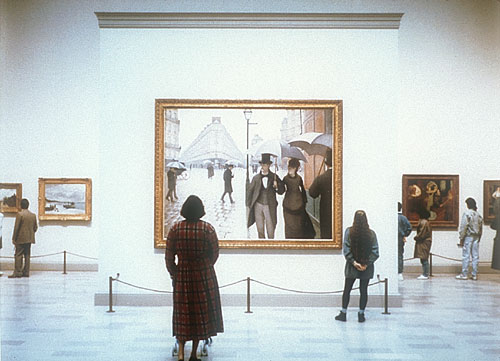
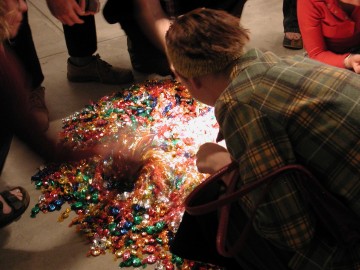




Pingback: Sous nos yeux (partie1) Kunsthalle Mulhouse | une dilettante